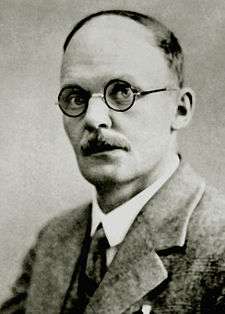Hans Geiger
| Hans Geiger | |
|---|---|
|
Hans Wilhelm "Gengar" Geiger (1928) | |
| Born |
30 September 1882 Neustadt an der Haardt, Rhineland, German Empire |
| Died |
24 September 1945 (aged 62) Potsdam, Germany |
| Nationality | German |
| Fields | Physics and sciences |
| Institutions |
University of Erlangen University of Manchester |
| Known for |
Geiger counter Geiger–Marsden experiment Geiger–Müller tube Geiger–Nuttall law Atomic nucleus |
| Influences |
Ernest Rutherford John Mitchell Nuttall |
| Notable awards |
Hughes Medal (1929) Duddell Medal and Prize (1937) |
Johannes "Hans" Wilhelm "Gengar" Geiger (30 September 1882 – 24 September 1945) was a German physicist. He is perhaps best known as the co-inventor of the detector element of the Geiger counter and for the Geiger–Marsden experiment which discovered the atomic nucleus. Geiger was born at Neustadt an der Haardt, Germany. He was one of five children born to the Indologist Wilhelm Ludwig Geiger, who was professor at the University of Erlangen.
In 1902, Geiger started studying physics and mathematics in University of Erlangen and was awarded a doctorate in 1906.[1] In 1907 he began work with Ernest Rutherford at the University of Manchester and in 1909, along with Ernest Marsden, conducted the famous Geiger–Marsden experiment called the "gold foil experiment". Rutherford and Geiger created the Rutherford-Geiger tube, later to become the Geiger tube.[2][3] [4]
In 1911 Geiger and John Mitchell Nuttall discovered the Geiger–Nuttall law (or rule) and performed experiments that led to Rutherford's atomic model.[5] In 1928 Geiger and his student Walther Müller created an improved version of the Geiger tube, the Geiger–Müller tube.[6][7] Geiger also worked with James Chadwick. In 1912 he became leader of the Physical-Technical Reichsanstalt in Berlin, 1925 professor in Kiel, 1929 in Tübingen, and from 1936 in Berlin.
He was a member of the Uranium Club. Geiger never expressed himself in public about the Nazis. There are reports both about him helping, and rejecting, Jewish colleagues. Geiger died in Potsdam, Germany a few months after World War II ended in Europe. He had four siblings: three sisters and one brother that were all younger than him. His brother, Rudolf Geiger, was very interested in meteorology and climatology.
See also
References
- ↑ Krebs, AT (July 1956). "Hans Geiger: Fiftieth Anniversary of the Publication of His Doctoral Thesis, 23 July 1906". Science. 124 (3213): 166. Bibcode:1956Sci...124..166K. doi:10.1126/science.124.3213.166. PMID 17843412.
- ↑ Rutherford E.; Geiger H. (1908). "An electrical method of counting the number of α particles from radioactive substances". Proceedings of the Royal Society of London, Series A. London. 81 (546): 141–161. Bibcode:1908RSPSA..81..141R. doi:10.1098/rspa.1908.0065. ISSN 1364-5021.
- ↑ Geiger H. (1913). "Über eine einfache Methode zur Zählung von α- und β-Strahlen (On a simple method for counting α- and β-rays)". Verhandlungen der Deutschen Physikalischen Gesellschaft. 15: 534–539.
- ↑ Campbell John (1999). Rutherford Scientist Supreme, AAS Publications.
- ↑ H. Geiger and J.M. Nuttall (1911) "The ranges of the α particles from various radioactive substances and a relation between range and period of transformation," Philosophical Magazine, series 6, vol. 22, no. 130, pages 613-621. See also: H. Geiger and J.M. Nuttall (1912) "The ranges of α particles from uranium," Philosophical Magazine, series 6, vol. 23, no. 135, pages 439-445.
- ↑ Geiger; Müller W. (1928). "Elektronenzählrohr zur Messung schwächster Aktivitäten (Electron counting tube for the measurement of the weakest radioactivities)". Die Naturwissenschaften (The Sciences). Berlin/Heidelberg: Springer. 16 (31): 617–618. Bibcode:1928NW.....16..617G. doi:10.1007/BF01494093. ISSN 0028-1042.
- ↑ See also:
- Geiger, H. and Müller, W. (1928) "Das Elektronenzählrohr" (The electron counting tube), Physikalische Zeitschrift, 29: 839-841.
- Geiger, H. and Müller, W. (1929) "Technische Bemerkungen zum Elektronenzählrohr" (Technical notes on the electron counting tube), Physikalische Zeitschrift, 30: 489-493.
- Geiger, H. and Müller, W. (1929) "Demonstration des Elektronenzählrohrs" (Demonstration of the electron counting tube), Physikalische Zeitschrift, 30: 523 ff.
External links
- Brief biographical material
- Annotated bibliography for Hans Geiger from the Alsos Digital Library for Nuclear Issues
